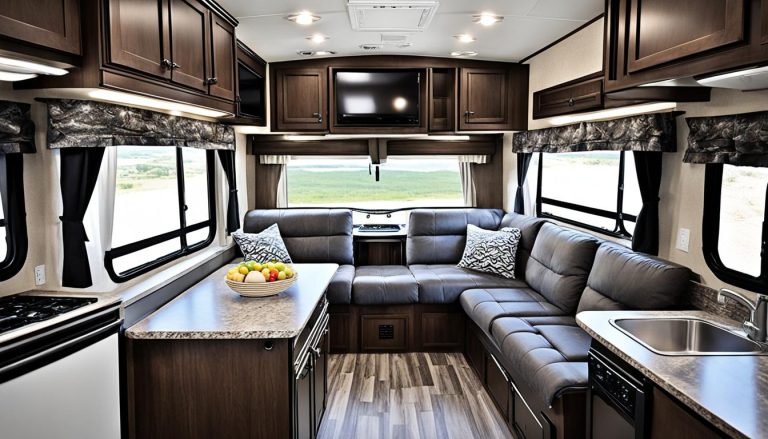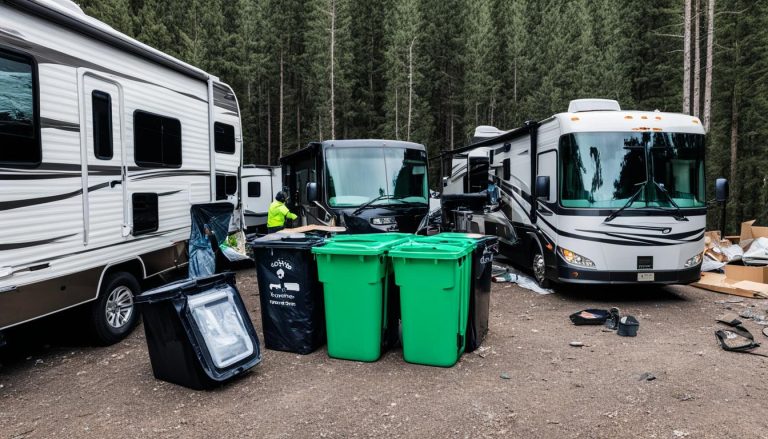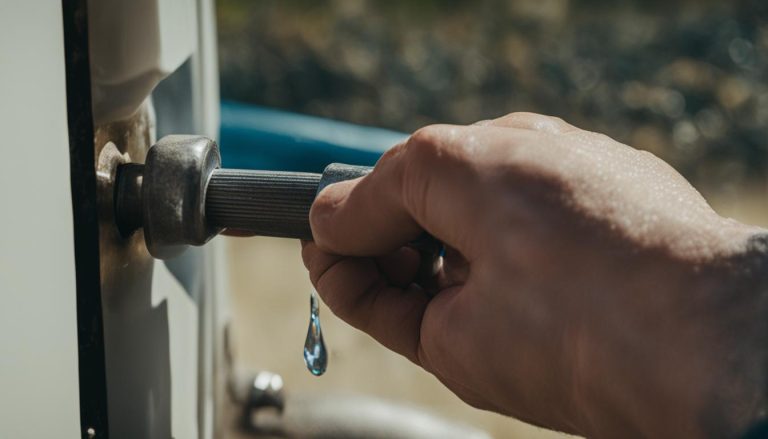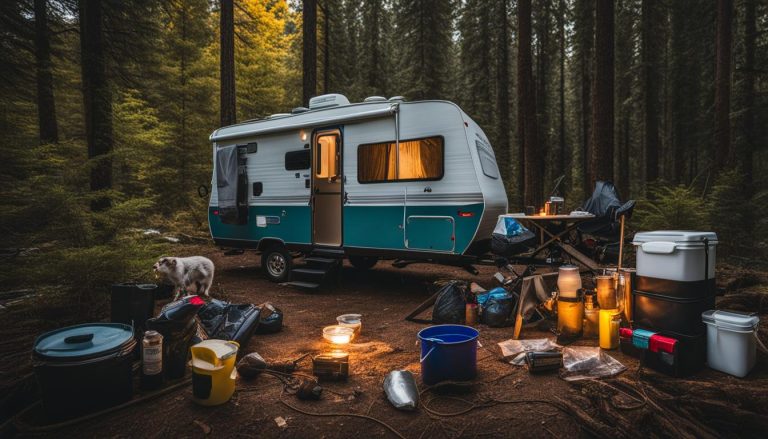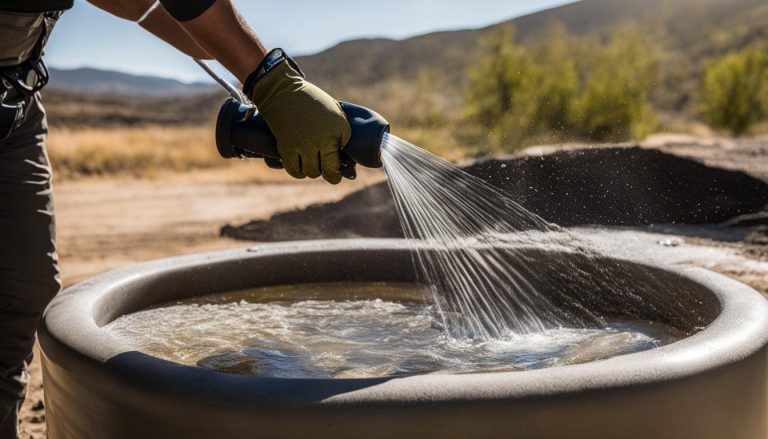Winterize Your RV: Prevent Freezing in Winter
gorvlifestyle.com and its partners may earn a commission if you purchase a product through one of our links
Freezing temperatures can wreak havoc on your RV’s plumbing system, causing costly damage and repairs. To ensure that your RV stays safe and functional during the winter months, it is crucial to take preventive measures to protect it from freezing. With a few simple steps, you can safeguard your RV and avoid the headache of frozen pipes and tanks.
When it comes to preventing freezing in your RV, there are several best practices you can implement. From dumping your waste to insulating your pipes and RV, each step plays a crucial role in keeping your RV in top shape during the cold winter weather.
Key Takeaways:
- Dumping your waste is essential to prevent freezing and maintain sanitation.
- Insulating your pipes will protect them from freezing and maintain proper water flow.
- Properly insulating your RV will keep cold air out and minimize the risk of freezing in the plumbing system.
- Heating the interior of your RV will help prevent freezing and maintain a comfortable temperature.
- Using a tank heating pad is an effective method to keep your pipes and tanks warm during the winter months.
Dump Your RV Waste if You’re Storing It
Emptying the waste from your black water and grey water tanks is an essential step in preparing your RV for winter. By keeping the tanks clean and empty, you eliminate the possibility of water freezing and causing damage to your plumbing system. Additionally, proper waste disposal helps maintain sanitation and prevents unpleasant odors. Make sure to follow the proper procedures for dumping your RV waste to ensure a smooth and hassle-free process.
Proper waste disposal is crucial to prevent freezing issues in your RV’s plumbing. When storing your RV in winter, make sure to dump your black water and grey water tanks to avoid any potential damage. Keeping your tanks clean and empty will help protect your plumbing system and maintain a hygienic environment. Proper waste disposal is an important part of winter RV maintenance.
To properly dump your RV waste, follow these tips:
- Locate the dump station: Find a nearby dump station or RV park equipped with a dumping facility. Plan your route accordingly to ensure ease of access.
- Prepare your tools: Gather all the necessary tools and equipment, such as sewer hoses, gloves, and a sewer hose support. It’s important to have everything ready to avoid any last-minute hassles.
- Position your RV: Park your RV in a way that aligns with the dump station. Ensure that the sewer hose can reach the dump inlet without any kinks or obstructions.
- Connect the sewer hose: Attach one end of the sewer hose securely to the RV’s waste outlet and the other end to the dump inlet. Make sure the connections are tight to prevent any leaks.
- Open the valves: Slowly open the black water tank valve first, followed by the grey water tank valve. Let the waste flow out gradually, allowing the tanks to empty completely.
- Rinse the tanks: After the tanks are empty, use a dedicated tank rinser or a hose with a high-pressure nozzle to flush out any remaining residue.
- Close the valves and clean up: Close the tank valves securely and ensure all connections are disconnected properly. Rinse and clean your sewer hose and equipment, and stow them away in a designated storage compartment.
Following these steps will help you safely and effectively dump your RV waste, preventing any freezing issues and ensuring a worry-free winter season.
| Benefits of Proper RV Waste Disposal |
|---|
| Prevents freezing and damage to your plumbing system |
| Maintains sanitation and prevents unpleasant odors |
| Helps maintain a clean and hygienic environment |
| Complies with regulations and etiquette at RV parks and dump stations |
Insulate Your Pipes
Insulating your RV pipes is a crucial step in winter RV maintenance to prevent freezing and ensure the best practices for keeping your RV from freezing. One of the most vulnerable areas is the fresh water tank and the pipes connected to it. By properly insulating these pipes, you can protect them from freezing temperatures and avoid costly repairs.
Professional insulation using closed cell spray foam is a highly effective method to insulate your RV pipes. This type of insulation creates a seamless barrier that minimizes heat transfer and prevents freezing. It is recommended to hire a professional to ensure proper installation and maximum efficiency.
If you prefer a do-it-yourself approach, you can purchase a pipe insulation kit designed for RVs. These kits typically include foam insulation tubes that you can easily install around the exposed pipes. Make sure to insulate all sections of the pipes, especially those located in colder areas or exposed to drafts.
Insulating your RV pipes not only helps prevent freezing but also contributes to keeping the interior of your RV warmer during the winter months. The insulation helps retain heat and reduces the risk of cold air seeping in. This can improve overall comfort and energy efficiency in your RV.
To provide a visual representation of the benefits of insulating your RV pipes, refer to the table below:
| Benefits of Insulating Your RV Pipes |
|---|
| Prevents freezing and potential damage to pipes |
| Improves energy efficiency by retaining heat |
| Enhances overall comfort inside the RV |
| Reduces the risk of cold air drafts |
Insulating your RV pipes is a vital step in protecting your RV from freezing temperatures. Whether you choose professional insulation or a DIY method, taking the time to insulate your pipes will ensure a safe and comfortable winter RVing experience.
Insulate Your RV
Protecting your RV from freezing temperatures is a crucial part of winterizing it. In addition to insulating your pipes, it’s important to insulate your entire RV to ensure optimal heat retention and prevent cold air from entering.
Insulating the walls, windows, and doors of your RV will create a barrier against the freezing weather, helping to maintain a comfortable and warm interior. By minimizing heat loss, you can reduce the risk of freezing in the plumbing system and keep your RV functional throughout the winter months.
Weatherproofing your RV also has the added benefit of keeping pests, such as rodents, out of your rig. Insulated walls and doors make it more difficult for critters to access your RV, providing extra peace of mind during the winter season.
There are several options available for insulating your RV. You can consider using door and window insulation kits, which provide an easy and effective solution for sealing any drafts or gaps. These kits typically include weatherstrips and foam tape, which can be applied around doors and windows to create a tight seal.
For a more comprehensive insulation solution, you may also hire professionals to insulate your RV. They can use high-quality insulation materials to ensure maximum heat retention and protection against freezing temperatures.
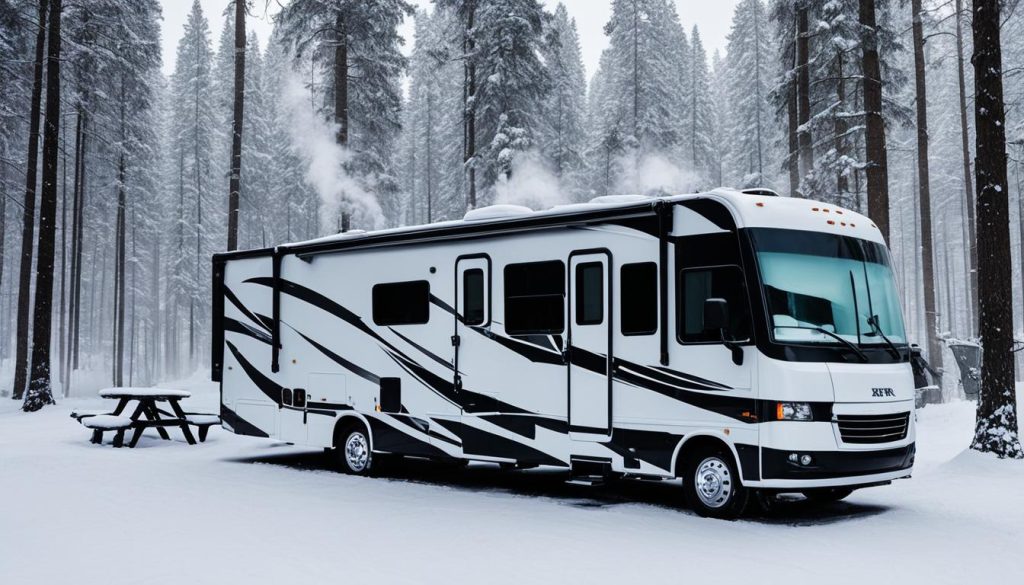
Benefits of RV Insulation
Insulating your RV offers several key benefits:
- Minimizes the risk of freezing in the plumbing system
- Helps maintain a comfortable and warm interior
- Reduces energy consumption by minimizing heat loss
- Keeps pests, such as rodents, out of your RV
RV Insulation Types
| Insulation Type | Features |
|---|---|
| Spray Foam Insulation | Fills gaps and creates a seamless barrier. Provides excellent insulation and soundproofing. |
| Fiberglass Batt Insulation | Easy to install and cost-effective. Provides good thermal insulation. |
| Rigid Foam Insulation | Durable and moisture-resistant. Offers high thermal insulation value. |
Each type of insulation has its advantages and disadvantages, so it’s important to research and choose the option that best suits your needs and budget.
By insulating your RV, you can protect it from freezing temperatures, ensure a comfortable interior, and keep pests at bay. Consider investing in insulation materials or hiring professionals to effectively winterize your RV and enjoy a worry-free winter camping experience.
Heat the RV’s Interior
Keeping the interior of your RV warm is essential to prevent freezing in cold weather and ensure the proper winterization of your vehicle. By maintaining a consistent warmth inside the RV, you can effectively protect the pipes from freezing and avoid costly damage. Heat transfer plays a crucial role in this process, especially when the pipes are located in the flooring or the body of the RV.
To maintain a comfortable temperature and prevent freezing in the plumbing system, utilize the heating options available in your RV. These options include:
- Utilizing the built-in furnace: The RV’s furnace is designed to provide efficient heating throughout the vehicle. Make sure to set the temperature at an appropriate level to keep the interior warm. Regularly check the furnace to ensure it’s in proper working condition and have any necessary maintenance performed before the winter season.
- Using an electric heater: Supplementing the RV’s built-in furnace with an electric heater can help distribute heat more evenly throughout the vehicle. Place the electric heater in a central location, such as the living space or near the plumbing infrastructure, to optimize its effectiveness.
- Employing a portable floor heater: If you prefer additional heating options, consider using a portable floor heater. These heaters can be positioned strategically to target specific areas in need of warmth, such as the bathroom or the area around the pipes.
Remember to monitor the temperature inside your RV regularly and make adjustments as needed to maintain warmth and prevent freezing. By ensuring a comfortable and consistently heated interior, you can protect your plumbing system and enjoy a worry-free winter camping experience.
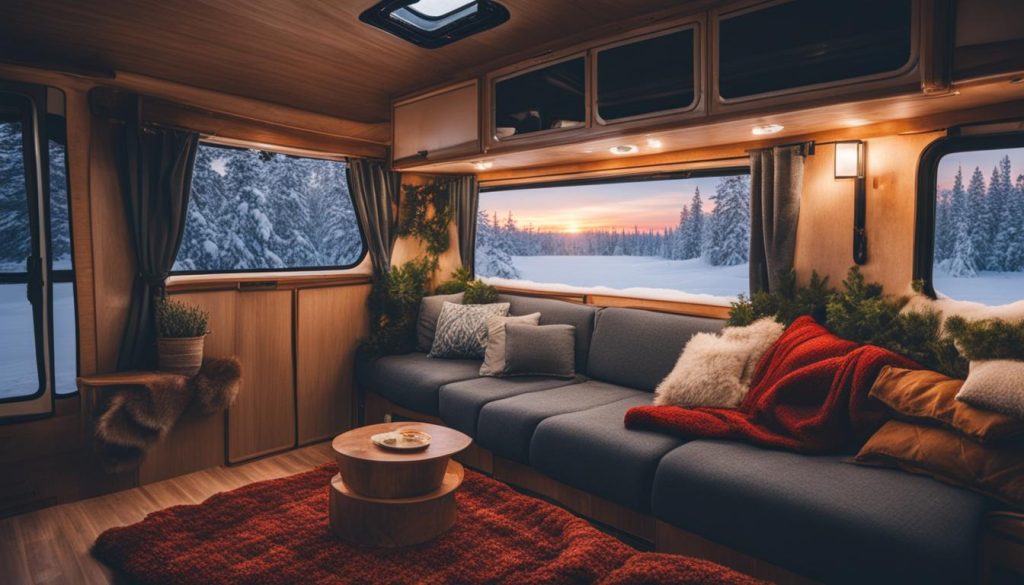
| Heating Option | Benefits |
|---|---|
| Built-in Furnace | – Provides efficient heating throughout the RV – Maintains a consistent temperature to prevent freezing – Professionally installed and integrated into the RV’s systems |
| Electric Heater | – Supplemental heating option to the built-in furnace – Helps distribute heat evenly throughout the RV – Freestanding and portable |
| Portable Floor Heater | – Provides targeted heating to specific areas – Ideal for bathrooms and areas near the plumbing infrastructure – Portable and easy to move around the RV |
Use a Tank Heating Pad
Preventing your RV’s plumbing from freezing in winter is crucial for winter RV maintenance to prevent freezing. One effective method to ensure your RV’s pipes and tanks stay warm is by installing a tank heating pad. These heating pads are designed to provide a controlled source of warmth, preventing freezing and potential damage.
The tank heating pad can be easily attached directly to the tanks or appliances that require heat. The heating pads come with temperature control features, allowing you to adjust the heat output based on the outdoor temperatures. This ensures that your plumbing system remains protected even in variable weather conditions.
By using a tank heating pad, you can have peace of mind knowing that your RV’s plumbing system is safe from freezing. In combination with other winterization techniques, such as insulating your pipes and properly heating the interior, the tank heating pad provides an added layer of protection against winter freeze-ups.
FAQ
How can I prevent my RV from freezing in winter?
There are several measures you can take to protect your RV from freezing temperatures. These include dumping your waste, insulating your pipes, insulating your RV, heating the interior, using a tank heating pad, and installing RV skirting.
Why is it important to dump my RV waste before winter?
Emptying the waste from your black water and grey water tanks is essential to prevent freezing and damage to your plumbing system. Proper waste disposal also helps maintain sanitation and prevents unpleasant odors.
How do I insulate my RV pipes to prevent freezing?
Insulating your RV pipes, especially the fresh water tank, is crucial for preventing freezing in cold weather. You can opt for professional insulation using closed-cell spray foam or purchase a pipe insulation kit for a DIY approach.
Why should I insulate my entire RV?
Insulating the walls, windows, and doors of your RV helps trap heat inside and prevent cold air from entering. This not only keeps your RV warmer but also minimizes the risk of freezing in the plumbing system. Weatherproofing your RV also helps keep pests out.
How can I heat the interior of my RV to prevent freezing?
Keeping the interior of your RV warm is crucial to prevent freezing. Utilize your RV’s built-in furnace, electric heater, or portable floor heater to maintain a comfortable temperature and prevent freezing in the plumbing system.
What is a tank heating pad and how does it help prevent freezing?
A tank heating pad is a device that can be attached directly to your RV’s pipes or tanks to provide controlled heat and prevent freezing. These pads typically have temperature control features, ensuring your plumbing system remains protected in variable weather conditions.

